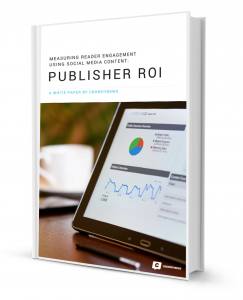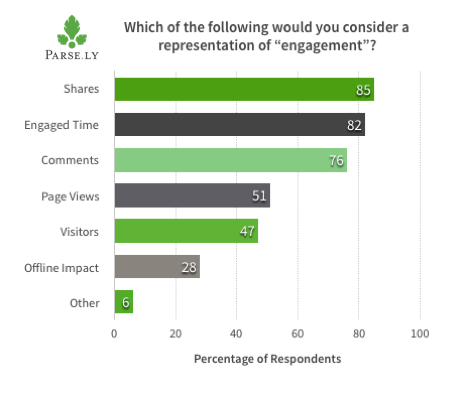Many online publishers have spent the last few years trying to attract as many visitors to their website and apps as possible. However, due to several developments such as the fact that the number of ad-blocker users skyrocketed in 2015, publishers were forced to rethink their online strategy and started putting a greater focus on maximizing loyalty and engagement.
Enhancing audience engagement is important, because engaged users are more likely to trust a publisher’s brand. They return more often to the website, visit more pages during a session and are more inclined to sign up for an email newsletter. And most importantly, they are more likely to convert to paid subscribers. Simultaneously, revenue per ad is boosted because advertisers are willing to pay more for positions on a highly valued, highly engaged website.
The definition of audience engagement
So logically, the publishing industry has been talking about audience engagement a lot lately. But what does it really mean? It’s hard to find a definition of the term “audience engagement”, so I decided to split it up. The Cambridge dictionary says that engagement, besides agreeing to marry someone, is:
- the fact of being involved with something;
- the process of encouraging people to be interested in the work of an organization, etc.
Even though the definition is still quite vague, it implies a happy feeling, people who like what you do or who you are. So regarding audience engagement for online publishers, I propose the following definition:
“The extent to which website visitors are interested or actively involved in your content.”
Issues with metrics often used to measure audience engagement
In order to measure audience engagement, we need to identify the metrics that capture the level of interest and involvement website visitors show in publisher’s content. Recent research from Parse.ly however shows that the majority of publishers lack a clear understanding of how their sites define audience engagement. The following variables were considered a representation of engagement:
The variables listed above can be problematic: the issue with “Shares” is that people can share stories from their social media accounts without clicking to the publisher’s site to read the full story. Would you call those users engaged? “Page Views” tells you how many users clicked over to your page, (maybe because they liked the title) but it doesn’t say anything about engagement on that page.
The real engagement metrics
Parse.ly’s survey illustrates how difficult it is to clearly define the term audience engagement and how to measure it. Referring back to the definition used before, I believe it’s important to focus on the metrics that indicate an active involvement by the user, not just page views or uniques. At Crowdynews, we therefore use the following metrics to determine whether a publisher’s audience is engaged:
1) Average # of pages per session
The more pages a user visits during a session, the higher the engagement level. Please note that if you have a section on your site that contains longer articles, a low # of pages per session isn’t necessarily a bad thing. In that case, average session duration and engaged time are especially helpful.
2) Average session duration
In general, the longer an average session, the more a user is engaged, as he or she chooses to spend more time on your website. The drawback is that if someone leaves the page open without being active, it still counts as a session. If you have sections on your site with a lot of short articles on different URLs, average # pages per session gives better insights.
FREE DOWNLOAD
Download the whitepaper: “Measuring Reader Engagement Using Social Content” and find out how adding relevant social media content to your editorial articles affects your audience engagement metrics!
3) Bounce rate
If the bounce rate is high, that means a large percentage of your visitors click off of your website instead of viewing other pages. Therefore, a low bounce rate means higher engagement. The landing page has peaked their interested and the visitor clicks through to additional pages on your website.
4) Returning Visitors vs New Visitors
A high percentage of new users vs returning users means that fewer users are returning to your website – perhaps because they were not engaged the last time they visited. To enhance audience engagement, a higher percentage of returning visitors is important.
5) # Shares from your article pages
This tells you that a visitor is actually on one of your pages, and has shared the story. He or she is actively involved with your content.
6) Engaged time
The previous statistics can all be found in Google Analytics. However, as with all metrics, they shouldn’t be interpreted too ‘black and white’. For example, long session durations aren’t necessarily a good thing for audience engagement – someone might have left the browser open without paying attention to it. Therefore, it is important to also capture other data that indicate someone is paying attention to your content. You can do this by measuring clicks on website elements, or recording scroll positions.

These metrics all help quantify engagement: the level of interest that your audience shows in you and your content. And most importantly, they happen on your domain. Likes and shares of your article on social media imply interest, but that doesn’t necessarily translate into an interest in your brand.
The list is not meant as an exhaustive list, because some things are just not measurable. Like when a reader emails you or talks to you in person to say what a great, interesting piece you’ve written. It’s meant as a practical list that gives you an overview of the stats that are, from the publishers we speak with, the most relevant for audience engagement.
Also, for each publisher, it’s probably different what numbers they should aim for. What’s important is that you establish a baseline, and set reasonable goals for a finite period of time. Then, you can measure, analyze and compare data for different articles and website sections to see what works best and what needs adjustment.
Other articles you might find interesting:
- How Social Media Streams Boost Audience Engagement
- 5 Effects of Social Media on Digital Publishing
- Digital Publishing in 2017: The Role of Distribution Platforms, Mobile, Video and Ad Blocking
- How Millennials’ Social Media Habits Will Change in 2017
FREE DOWNLOAD
Download the whitepaper: “Measuring Reader Engagement Using Social Content” and find out how adding relevant social media content to your editorial articles affects your audience engagement metrics!

